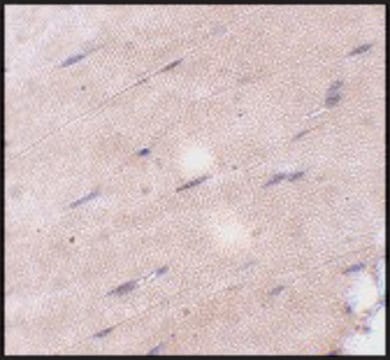推荐产品
生物源
mouse
抗體表格
purified from hybridoma cell culture
無性繁殖
TFE3-37, monoclonal
形狀
buffered aqueous solution
分子量
60 kDa
物種活性
human, mouse, bovine, rat, canine
包裝
antibody small pack of 25 μL
濃度
~1 mg/mL
技術
immunoblotting: 1.5-3 μg/mL using human A549 cells extract
同型
IgG1
UniProt登錄號
運輸包裝
dry ice
儲存溫度
−20°C
目標翻譯後修改
unmodified
基因資訊
human ... TFE3(7030)
一般說明
Transcription factor E3 (TFE3), also known as Class E basic helix-loop-helix protein 33 (bHLHe33), is a transcriptional activator that mediates the enhancer-promoter interactions. TFE3 belongs to the MiT family of helix-loop-helix leucine zipper transcription factors, it is ubiquitously expressed and can directly associate with DNA as either homodimer or heterodimer which are formed with two other MiT family members, TFEB or TFEC.
TFE3 serve an important role in cell growth, cell proliferation, cellular adaptation to starvation and cellular response to ER stress. Under nutrient-rich conditions, TFE3 is located in the cytoplasm, and under starvation conditions or treatment with ER stressors, TFE3 rapidly translocates to the nuclear. In the nuclear localization, TFE3 mediates cellular adaptation to stress by simultaneously promoting lysosomal biogenesis, autophagy induction, as well as expression of critical mitochondrial and metabolic regulators. It been shown that TFE3 also participate in the transcriptional regulation of the innate immune response.
Pathogen infections promote TFE3 nuclear translocation, thus inducing In vivo expression of several cytokines and chemokines.
TFE3 serve an important role in cell growth, cell proliferation, cellular adaptation to starvation and cellular response to ER stress. Under nutrient-rich conditions, TFE3 is located in the cytoplasm, and under starvation conditions or treatment with ER stressors, TFE3 rapidly translocates to the nuclear. In the nuclear localization, TFE3 mediates cellular adaptation to stress by simultaneously promoting lysosomal biogenesis, autophagy induction, as well as expression of critical mitochondrial and metabolic regulators. It been shown that TFE3 also participate in the transcriptional regulation of the innate immune response.
Pathogen infections promote TFE3 nuclear translocation, thus inducing In vivo expression of several cytokines and chemokines.
應用
Anti-TFE3 antibody specifically recognizes TFE3 from human, mouse, rat, bovine and canine origin. The antibody may be used in various immunochemical techniques including Immunoblotting (~60 kDa). Detection of the TFE3 band by Immunoblotting is specifically inhibited by the immunizing peptide.
外觀
Supplied as a solution in 0.01 M phosphate buffered saline pH 7.4, containing 15 mM sodium azide as a preservative.
其他說明
Unless otherwise stated in our catalog our products are intended for research use only and are not to be used for any other purpose, which includes but is not limited to, unauthorized commercial uses, in vitro diagnostic uses, ex vivo or in vivo therapeutic uses or any type of consumption or application to humans or animals.
免責聲明
This product is for R&D use only, not for drug, household, or other uses.
儲存類別代碼
10 - Combustible liquids
水污染物質分類(WGK)
WGK 1
閃點(°F)
Not applicable
閃點(°C)
Not applicable
José A Martina et al.
Science signaling, 7(309), ra9-ra9 (2014-01-23)
The discovery of a gene network regulating lysosomal biogenesis and its transcriptional regulator transcription factor EB (TFEB) revealed that cells monitor lysosomal function and respond to degradation requirements and environmental cues. We report the identification of transcription factor E3 (TFE3)
Nunzia Pastore et al.
Autophagy, 12(8), 1240-1258 (2016-05-14)
The activation of transcription factors is critical to ensure an effective defense against pathogens. In this study we identify a critical and complementary role of the transcription factors TFEB and TFE3 in innate immune response. By using a combination of
我们的科学家团队拥有各种研究领域经验,包括生命科学、材料科学、化学合成、色谱、分析及许多其他领域.
联系技术服务部门








